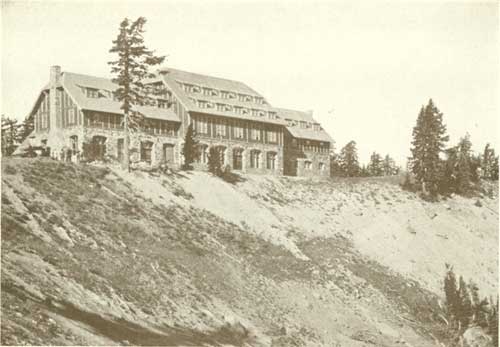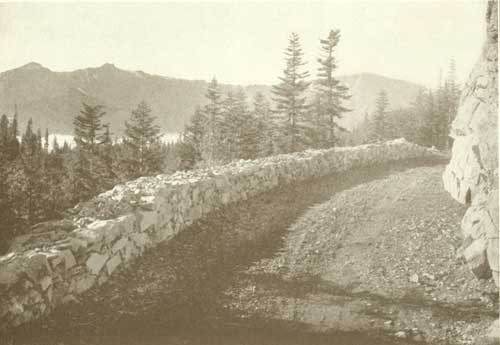|
NATIONAL PARKS PORTFOLIO
|
CRATER LAKE NATIONAL PARK
THE MINE OF BEAUTY
 RATER LAKE is seen in its glory from a launch. One
may float for days upon its surface without sating one's sense of
delighted surprise; for all is new again with every change of light. The
Phantom Ship, for instance, sometimes wholly disappears. Now it is
there, and a few minutes after, with new slants of light, it is
gone—a phantom indeed. So it is with many headlands and ghostlike
palisades.
RATER LAKE is seen in its glory from a launch. One
may float for days upon its surface without sating one's sense of
delighted surprise; for all is new again with every change of light. The
Phantom Ship, for instance, sometimes wholly disappears. Now it is
there, and a few minutes after, with new slants of light, it is
gone—a phantom indeed. So it is with many headlands and ghostlike
palisades.
This lake was not discovered until 1853. Eleven Californians had undertaken once more the search for the famous, perhaps fabulous, Lost Cabin Mine. For many years parties had been searching the Cascades; again they had come into the Klamath region. With all their secrecy their object became known, and a party of Oregonians was hastily organized to stalk them and share their find. The Californians discovered the pursuit and divided their party. The Oregonians did the same. It became a game of hide-and-seek. When provisions were nearly exhausted and many of both parties had deserted, they joined forces.
"Suddenly we came in sight of water," writes J. W. Hillman, then the leader of the combined party; "we were much surprised, as we did not expect to see any lakes and did not know but that we had come in sight of and close to Klamath Lake. Not until my mule stopped within a few feet of the rim of Crater Lake did I look down, and if I had been riding a blind mule I firmly believe I would have ridden over the edge to death."
It is interesting that the discoverers quarrelled on the choice of a name, dividing between Mysterious Lake and Deep Blue Lake. The advocates of Deep Blue Lake won the vote, but in 1869 a visiting party from Jacksonville renamed it Crater Lake, and this, by natural right, became its title.

|
|
THE FAVORITE WAY TO SEE THE SCULPTURED CLIFFS IS FROM A MOTOR-BOAT Photography by Fred H. Kiser |
UNUSUAL FISHING
This magnificent body of cold fresh water originally contained no fish of any kind. A small crustacean was found in its waters in large numbers, the suggestion, no doubt, upon which was founded the Indian legend of the gigantic crawfish which formed the bodyground of the great god Llao.

|
|
TROUT RUN FROM ONE TO SIX POUNDS Photograph by Fred H. Kiser |
In 1888 Will G. Steel brought trout fry from a ranch forty miles away, but no fish were seen in the lake for more than a dozen years. Then a few were taken, one of which was fully thirty inches long.
Since then trout have been taken in ever-increasing numbers. They are best caught by fly casting from the shore. For this reason the fishing is not always the easiest. Often the slopes are not propitious for casting. One has to climb upon outlying rocks to reach the waters of best depth. But the results usually justify the effort. The trout range from one to ten pounds in weight. Anglers of experience in western fishing testify that, pound for pound, the rainbow trout taken in the cold deep waters of Crater Lake are the hardest-fighting trout of all.
Many fish are also taken from rowboats. A trolling spoon will often lure large fish.

|
|
CAMPING OUT BACK OF THE RIM Photograph by H. T. Cowling |
HOTELS AND CAMPS
Partly because it is off the main line of travel, but chiefly because its unique attractions are not yet well known, Crater Lake has been seen by comparatively few. Under concession from the Department of the Interior, a comfortable camp is operated five miles from the lake, and a newly completed hotel and camp on the lake's rim. The hotel is built of the stone of the neighborhood and is fully equipped with baths. Tents may be had for those who prefer camping.

|
|
AT THE FOOT OF THE TRAIL FROM CRATER LAKE LODGE Photograph by H. T. Cowling |

|
|
CRATER LAKE LODGE ON THE RIM, 1,000 FEET ABOVE THE LAKE The lounge occupies the entire ground floor of the center segment of the building, is 40 by 60 feet, without a pillar or post, and contains what is said to be the largest fireplace in the State of Oregon |

|
|
ACROSS THE LAKE FROM THE RIM ROAD Photograph by Fred H. Kiser, Portland, Oregon |
| <<< Previous | <<< Contents>>> | Next >>> |
yard1/crla6.htm
Last Updated: 30-Oct-2009